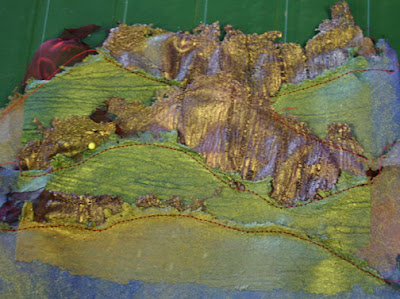Creative Fibre Festival - 2 day workshop part 1
Painted Vilene Spunbond CS 800 with Bondaweb ironed onto the back, cut with a soldering iron and ironed onto black cotton - basically applique - just using a soldering iron to cut the fabric as opposed to scissors.
This technique can only be done with synthetic fabrics - soldering irons will not cut natural fabrics.
After the joys of the Creative Fibre Festival (www.fibrefestival2012.blogspot.co.uk do have a look and scroll right down)
I taught a 2 day workshop - Extreme Surfaces for Stitch - Because some of the students weren't aware of some of the basic techniques we started right at the beginning so we ended up with more of a Slightly Less Extreme Surfaces for Stitch. The main thing is the students got the information that they needed.
Painted Bondaweb and various weights of Vilene Spunbond drying.
I thought Alison's plastic apron was particularly fetching - on the right.
Denise my minder mucking about for the camera on the left and Christine working hard painting Vilene Spunbond on the right.
We started off painting Tyvek, Bondaweb and Vilene Spunbond then we used procion dye powder and water to colour various weights of sew in and iron on interfacings. (I know this doesn't 'dye' the fabrics but it is a cheap way to colour a lot of product that won't be washed).
Because we were having a 2 day workshop we had the luxury of spending a whole morning just playing with colour - sloshing it on play school style. It is very relaxing not to have worry what you are painting is going to look like.
After cleaning up we had lunch which gave most of the products enough time to dry.
As usual I am doing things back to front - we started on the painted Bondaweb which I will show you tomorrow, the samples were so good I need a whole post to show them off.
Here are some of the applique samples using various weights of painted Vilene Spunbond cut with a soldering iron. Whenever I use soldering irons for an exercise I always make sure that the students use an upturned ceramic flower pot as a stand for their soldering irons. This system was developed by Margerat Beal and cannot be beaten for safety. It is always a nightmare when the soldering irons come out as so many things can happen - they can roll off the little metal stands very easily. Used safely they are a brilliant tool.
I apologise for this sample not being in focus, I was enjoying myself so much I forgot to take photos as we went along and therefore had to rush around at the end. I didn't want to leave this sample out as it was such a good example of positive and negative shapes.
Layers of Tyvek and polyester organza stitched together and then zapped with a heat gun.
Having fun playing with Tyvek to create interesting shapes.
Layers of polyester organza decorated with painted Bondaweb stitched together and then zapped with a heat gun.
Polyester organza decorated with painted Bondaweb and then zapped with a heat gun.
Painted Tyvek heated and shaped in to a corsage.
Polyester organza decorated with painted Bondaweb, zapped to distress with a heat gun then shaped into a corsage.
Painted Vilene Spunbond that has been zapped with a heat gun to create gorgeous edges and then machine stitched together in layers.
A sketchbook cover decorated with painted Bondaweb, Heat transfer foils and gilding flake.
This beautiful book cover was created using a painted Bondaweb sample on black cotton to make a slip cover. The sample was finished (over night) with hand stitch in gold thread.
a detail of the book cover - stunning!
So I think you can see we had a good time and the students produced some fabulous samples. I will post again tomorrow and show you the decorated Bondaweb samples.
I'm off to have my hair cut and re-coloured I will then finish unpacking my suitcases and then tonight - I am off to Pizza Express with my mate Judy to have a catch up - what a FAB day!
X





























Comments
Post a Comment